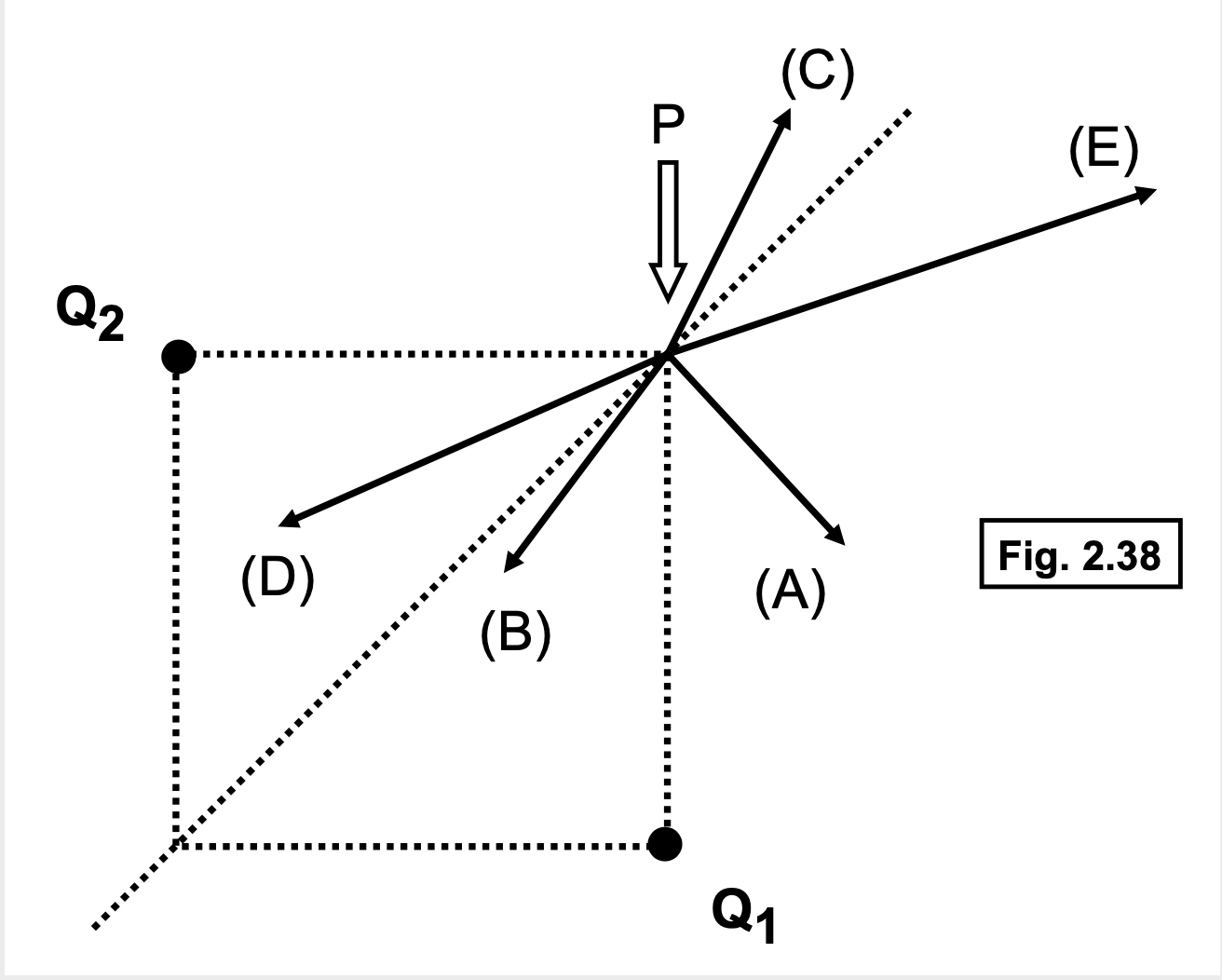Question

Transcribed Image Text:(C)
(E)
Q2
Fig. 2.38
(D)
(A)
(B)
Q1

Transcribed Image Text:Problem 14: For the two point charges, Q1 and Q2, shown in the figure for Problem 1, and
the electric field, E, generated by Q1 and Q2 at point P, assume that Q2 = -3.0nC, the
sidelength of the square is 6.0cm, and the electric field strength at P is E := |E| = 12.5kV/m.
Allowing for the possibility that Q1 could be either positive or negative, find all possible
values of Q1.
Expert Solution
This question has been solved!
Explore an expertly crafted, step-by-step solution for a thorough understanding of key concepts.
Step by stepSolved in 3 steps with 3 images

Knowledge Booster
Similar questions
- Please help, thank you!arrow_forwardA uniformly charged rod of length L and total charge Q lies along the x axis as shown in in the figure below. (Use the following as necessary: Q, L, d, and ke.) Ey= P d Ⓡ (a) Find the components of the electric field at the point P on the y axis a distance d from the origin. Ex= Eyz (b) What are the approximate values of the field components when d >> L? Ex L Explain why you would expect these results. This answer has not been graded yet. Need Help? Read Itarrow_forwardmylabmastering.pearson.com/?courseld=12649908&key=1368321332824583800122024#/ A +12 nC charge is located at the origin. L 20 F3 F4 What is the electric field at the position (21, y₁) = (5.0 cm, 0 cm)? Enter the x and y components of the electric field in newtons per coulomb separated by a comma. 195| ΑΣΦ Ez. E,= 4.32.104,2.2.104 Submit Part B X Incorrect; Try Again; 4 attempts remaining Ez. Ey = Submit Part C What is the electric field at the position (2, 32) = (-5.0 cm, 5.0 cm)? Enter the x and y components of the electric field in newtons per coulomb separated by a comma. Previous Answers Request Answer % F5 [5] ΑΣΦΑ Request Answer → ἘΨΕΙ ΑΣΦ ^ What is the electric field at the position (3, 3)= (-5.0 cm, -5.0 cm)? Enter the x and y components of the electric field in newtons per coulomb separated by a comma. MacBook Air F6 ww ? & F7 ? N/C ? N/C DII FB DD -D FM + Update Reviewarrow_forward
- Consider the electric field of a point charge.At point A the electric field strength is 9 V/m, at point B the electric field strength is 36 V/m. We measure the strength of the electric eld at the midpoint of the interval AB. What can be the measured value?arrow_forwardQuestion: In the figure particle 1 of charge q1 = -4.99g and particle 2 of ... Continue to post In the figure particle 1 of charge g= 4.99q and particle 2 of charge g2 = +3.39g are fixed to an x axis. As a multiple of distance L, at what coordinate on the axis is the net electric field of the particles zero? 19 questions remaining g am t . nyda ma My Textbook Solutions Show transcribed image text View comments (1) > Organic. University. Introductio.. 4th Edition 2nd Edition 4th Edition Expert Answer View all solutions Anonymous answered this Was this answer helpful? 2,147 answers Create an As ter the qwen inviting air. Adjust the mood in enyizeroom L-X Sho sam's Elec rie fuld olu to : - K4 99 q Elac tue fuld dut -K 3-39 to EL - Ka2 tet u Pu the pount where Egut =D- asseume So, - 4 99 Kg 3.99 kg 3.99 4 99 (L-x)! Please explin neatly and Cleally how to get from e step by step, to finally Solve foe X. 3-99 x 4 99 CL-x)L E5.6892 L Ans Cornment > Thank ypu! Practice with similar questions…arrow_forward1. Consider the four point charges shown in the figure on the right, arranged on the edges of a square of side a. a) Find the value of Q (in terms of g), such that the electric field at the center of the square points down (i.e., it only has a -y component). Show all work and justify any assumptions you -29 a a/2 make. b) Assuming Q has the value found in part (a), find the force exerted by the four corner charges on a fifth charge -q placed at the center of the square. c) Also using the result from (a), find the electric field at point P (shown in the figure) created by the four corner charges (there is no charge at the center of the square for this part).arrow_forward
arrow_back_ios
arrow_forward_ios